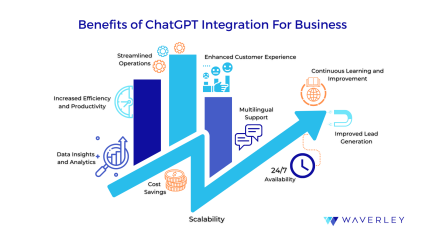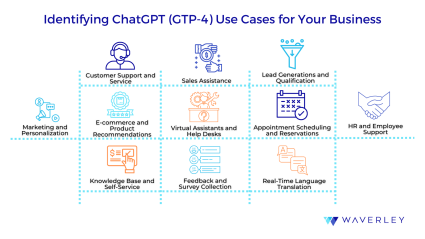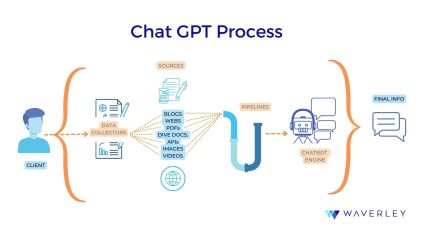These benefits can significantly enhance customer satisfaction, drive sales, and contribute to the overall success of a business. Let us give you more information in detail about ChatGPT and ChatGPT-4 for business, from what it is, to why it’s been so widely and successfully integrated into so many enterprises. A ChatGPT integration partner with practical experience, Waverley can become your guide to integrating ChatGPT with your business.
Understanding ChatGPT
OpenAI created ChatGPT, an AI language model with conversation-like functionality and possibilities for memory and customization. It uses the GPT-3.5 architecture and is intended to comprehend conversational settings and produce coherent responses. Natural language processing (NLP), which includes computers comprehending and interpreting human language, is at the heart of ChatGPT. In particular, the chatbot uses NLP algorithms to understand the context, intent, and meaning of user questions.
In order to accomplish this, the input text is processed and analyzed. It is then dissected into its components and important information is extracted using a variety of linguistic techniques. It is important to mention that ChatGPT has been trained on data created before 2021, and since then a new update is expected.
Once the input is known, this chatbot uses natural language generation (NLG) algorithms to produce logical and appropriately situated responses. In NLG, a text that resembles human speech is produced using an understanding of the input and the desired output. ChatGPT generates pertinent and insightful answers to user queries by using the knowledge and patterns it has discovered from its training data. One can now integrate with GPT-3.5 and GPT-4 APIs or with ChatGPT directly.
OpenAI has made their language models, notably GPT-3, accessible through APIs for integration and availability. These APIs give developers the ability to include ChatGPT or other GPT models into their programs, goods, or services and give consumers an interface through which to communicate with the models. However, OpenAI’s release and announcement plans would determine the accessibility and specifics of API access for models like GPT-4. For the most recent details on integration and API accessibility for their language models, it is advised to consult OpenAI’s official documentation and announcements.
The Benefits of ChatGPT Integration For Business

According to Exploding Topics, a portal dedicated to analyzing and collecting emerging topics that undergo explosive growth, ChatGPT currently serves over 100 million users. When considering AI development services, it’s essential to recognize the staggering reach of this AI tool. ToolTester, a platform used to assess and validate the functionality, quality, or performance of various tools, equipment, or systems, reports a staggering 1.6 billion monthly website visitors. Those statistics show the excessive growth and usefulness of the tool. But, what are the benefits of using it for business and how can it be applied?
There are many advantages and possible benefits to integrating ChatGPT into your business. Here are a few instances:
ScalabilityChatGPT is extremely scalable and can manage several consumer chats at once. Businesses may effectively manage a high volume of client interactions without relying on a lot of staff. Even during times of high demand, this scalability guarantees that client inquiries are promptly handled.
Multilingual SupportBusinesses may provide their clients with multilingual help thanks to ChatGPT’s language capabilities. It can connect with users and provide assistance in a variety of languages, removing linguistic barriers and extending the company’s reach to worldwide leads.
Enhanced Customer ExperienceThe user experience is the most crucial factor, which is why ChatGPT gives rapid responses to frequent questions as well as customized recommendations based on the needs. However, it is crucial to note that being very specific about the expected output is crucial for obtaining the required responses.
Data Insights and AnalyticsThis tool can provide insights into customer preferences, behavior patterns, and potential risks. These insights can be used by businesses to improve their product offers, marketing plans, and decision-making processes.
Getting real-time and unlimited responses is possible with a tool that knows no fatigue and can work around-the-clock. No matter where they are in the world, customers may get help at any time, which improves responsiveness and customer service.
Continuous Learning and ImprovementBased on user feedback and real-time interactions, ChatGPT can be improved and adjusted. This enables the system to learn from mistakes, increase its accuracy over time, and adapt to changing customer needs, ensuring ongoing improvement and customer satisfaction.
Cost SavingsIt lessens the need for extra support employees, particularly those who handle regular inquiries, to be hired and trained. Businesses may distribute resources more effectively, which will eventually save them a lot of money.
Streamlined OperationsVarious company activities, like order tracking, appointment scheduling, and troubleshooting, can be streamlined with the help of ChatGPT. Automating these processes lowers manual labor requirements, decreases mistakes, and boosts operational effectiveness.
Increased Efficiency and ProductivityChatGPT frees up human agents to focus on more difficult and valuable jobs by automating boring and repetitive tasks This boosts productivity and efficiency across the board for the company, freeing up staff to work on higher-value projects.
Improved Lead Generation“Hey I’m ChatGPT, an artificial intelligence, how can I help you?” With this tool, website visitors and potential buyers may interact with one another while receiving information about the company services and products and tailored recommendations. Through its sophisticated features, ChatGPT may improve lead qualification procedures, assisting your team in more effectively identifying and prioritizing high-potential prospects. Beyond initial identification, ChatGPT’s integration gives your company greater social media management, enabling interaction with potential leads on many channels generating unique content. Also, it enables effective and timely follow-up with leads by providing personalized and contextually relevant interactions.
Identifying ChatGPT (GTP-4) Use Cases for Your Business
Companies can get very creative in ways to leverage ChatGPT in their business. Waverley’s AI engineers together with business analysts are helping businesses across industries find the best possible applications to maximize the value and ROI of this tool. Waverley has talked to multiple companies looking into automating various aspects of their operations, and if we tried to sum up these areas where ChatGPT can most easily be used, we’d receive a list looking approximately like this:
1. Customer Support and Service: ChatGPT may answer consumer questions, offer immediate assistance, solve problems, and provide advice on products or services.
2. Sales Assistance: By giving details about goods or services, responding to client inquiries, and assisting potential clients through the sales process, ChatGPT can help sales teams.
3. Lead Generation and Qualification: In order to qualify leads based on predetermined criteria, ChatGPT can interact with website visitors, gather their information, and pass qualified leads to sales teams for further action.
4. Marketing and Personalization: Here, companies can improve and change their MKT strategies by harnessing the natural language processing prowess to craft compelling and personalized content. This includes tailoring marketing messages, emails, and advertisements to resonate deeply with individual consumers, thus enhancing engagement and conversion rates. Thanks to its intuitive understanding and capability to generate contextually rich responses businesses can create interactive chatbots that offer real-time assistance, answer customer inquiries, and guide potential buyers through the sales funnel. So, ChatGPT’s integration facilitates the creation of unique customer experiences.
5. E-commerce and Product Recommendations: This technology can assist users in a variety of ways, including helping them choose products, navigate e-commerce sites, and improve product recommendations. However, ChatGPT’s contribution to e-commerce goes beyond simple recommendations by encouraging a closer relationship between companies and their clients. ChatGPT increases user engagement and promotes repeat business by providing tailored interactions and assisting customers on their purchasing journeys.
6. Virtual Assistants and Help Desks: ChatGPT can help customers choose products, navigate e-commerce sites, and provide recommendations based on their interests and past purchases.
7. Appointment Scheduling and Reservations: ChatGPT can help businesses like healthcare providers, hairdressers, or restaurants with appointment scheduling, reservation making, and calendar availability management.
8. HR and Employee Support: By responding to frequent employee inquiries, assisting them in understanding HR policies and processes, and helping them with tasks like leave requests or benefits registration, ChatGPT can offer HR support.
9. Knowledge Base and Self-Service: Customers or staff members looking for self-service solutions can get information, detailed instructions, and troubleshooting advice from ChatGPT.
10. Feedback and Survey Collection: Customer feedback, surveys, and data on customer happiness, product preferences, or service quality can all be collected through ChatGPT.
11. Real-Time Language Translation: Real-time language translation can be facilitated by ChatGPT, expanding a company’s global reach and fostering cross-cultural relationships by assisting enterprises in communicating with clients or staff members who speak other languages.
Technical Architecture ExplanationBefore delving into its structure, take into account the following: as a tool for general use, it is one of the best options to be able to acquire specific information, although it has some exceptions.
An important consideration here is the issue of confidentiality, since all the information that is sent to this model automatically becomes public. Even OpenAI that recommends you not to share confidential information since all information that ChatGPT obtains is stored in its system and used to generate other responses.
On the other hand, it must be remembered that the model has a knowledge limit until 2021, which is why in commercial apps new knowledge is not sought, but rather, used to recognize the natural language in response and convert it into the same thing.
While confidentiality is an issue, you can control what information is sent to you. In addition, OpenAI recently introduced the Enterprise version of the tool that specifically addresses your information privacy. For a separate fee, your data is only used to train the model and tailor the responses for its users within your organization and does not go beyond.
Regarding the libraries, Langchain is used, which is written in Python and also has versions for Golang. It is important to remember that Python is the default language for integrating machine learning. This library is a wrapper that allows communication with different types of models.
Now, regarding the structure, it can be said that it has a generic diagram, the idea is that clients and agents can interact with the application. For that reason, you don’t need a different architecture to use ChatGPT or AI models. What is needed is a way to implement the information where a series of data collectors for machine learning are presented, which can be scripts in charge of accumulating information and, on the other hand, pipelines that process and transform that information.

The GPT-3.5 design, a variation of the Transformer model, serves as the foundation for ChatGPT. ChatGPT’s basic architecture is made up of a stack of many layers of feed-forward neural networks and self-attention techniques. It makes use of the attention mechanism to identify word dependencies within a particular input sequence and creates contextualized representations for every word. This enables the model to comprehend and produce responses that are coherent and appropriate for the setting.
We have different sources to obtain information such as web pages, blogs, images, databases, documents on the Drive, APIs, etc. The idea of collecting this information is to apply the models to be able to process them, and store them in local or system-specific databases.
The key is the type of database such as Vector Similarity to Share, which is responsible for collecting a paragraph of text, sending it to a model and obtaining a similarity vector using numerical arrays that allow you to index text or images or videos. So that when a question arrives about something specific, you can apply the same model to extract this vector and be able to make a comparison and search for the most similar documents, images or videos that you have based on that first comparison, allowing you to reduce the amount of information that you would have to send to Chat GPT to receive the expected response.
On the other hand, the intent classifier is found to extract what the person wants to do and even extract relevant information, for example:
Hello ChatGPT, I need to get an insurance certificate for my client XXXXXXX who has this policy number XXXXXXXXX.
That request reaches a chatbot Engine and with it the user tries to get the information based on the relevant data such as the name and the policy. Then, based on the action, you decide what you want to do and integrate with third-party APIs, which is what this specific app needs to perform validations, etc. And finally, the response is generated.
ChatGPT is built on the GPT-3.5 architecture, which is based on the Transformer model. The underlying architecture consists of multiple layers of self-attention mechanisms and feed-forward neural networks. The model’s purpose is to generate coherent and contextually relevant responses to user inputs. The architecture of ChatGPT includes the following key components:
Input Encoding: Embeddings are numerical representations that contain user messages and past system responses. The semantic meaning of the text is captured by these embeddings.
Self-Attention Layers: The Transformer model’s foundation is composed of these layers. They enable the model to recognize connections among various words in the input sequence. All points in the input sequence are attended to by self-attention mechanisms, which then balance representations while taking the context into account.
Feed-Forward Neural Networks: Feed-forward neural networks that are fully connected pass the self-attention outputs. The model can learn complex patterns and representations thanks to these networks’ numerous layers and nonlinear activation functions.
Output Generation: The output response is produced by the model’s last layer. It chooses the most likely next word based on context and forecasts the probability distribution over a lexicon of words.
How is ChatGPT Being Trained?Basically, it happens in two steps:
1. Pretraining:The model is trained using a sizable corpus of freely accessible text from the internet. Various sources, including books, articles, websites, and other publicly available content, make up this corpus. It’s crucial to keep in mind that the precise documents used for training are not made available to the public, and the model does not directly access any particular sources during inference. Predicting the next word in a sentence based on the previous context is a key part of training. This unsupervised learning exercise is referred to as “masked language modeling.” The model is taught to anticipate particular phrases that are randomly masked in the input based on the surrounding context. This happens throughout training.
2. Fine-tuning:After pretraining, the model is refined using OpenAI-created, unique datasets that include comparisons and demonstrations. Exposing the model to discussions in which human AI trainers take on the roles of both the user and the AI assistant is part of the fine-tuning process. Although the trainers have full control over the final content, they can use model-generated suggestions to help them when writing responses.OpenAI provides the trainers with instructions, and they get feedback on their actions to help the model perform better over time. A reward model that directs the fine-tuning procedure is developed using the information gathered from these interactions. The model’s parameters are updated using reinforcement learning strategies like Proximal Policy Optimization based on this reward model.
The amount of data needed to train a language model like ChatGPT is enormous. For instance, GPT-3.5 was trained on text input that totaled hundreds of gigabytes. To create a broad understanding of language, the model calls for exposure to a variety of subjects and writing types. The training data seeks to collect a representative sample of internet content in order to create an extensive language model, albeit the precise sources and documents utilized for training are not published.
It’s crucial to remember that while ChatGPT might produce information that is useful, it can also produce answers that are plausible-sounding but inaccurate or illogical. Instead of possessing actual comprehension or knowledge, it is a language model that creates text based on patterns acquired from the training data.


 Companies can get very creative in ways to leverage ChatGPT in their business. Waverley’s AI engineers together with business analysts are helping businesses across industries find the best possible applications to maximize the value and ROI of this tool. Waverley has talked to multiple companies looking into automating various aspects of their operations, and if we tried to sum up these areas where ChatGPT can most easily be used, we’d receive a list looking approximately like this:
Companies can get very creative in ways to leverage ChatGPT in their business. Waverley’s AI engineers together with business analysts are helping businesses across industries find the best possible applications to maximize the value and ROI of this tool. Waverley has talked to multiple companies looking into automating various aspects of their operations, and if we tried to sum up these areas where ChatGPT can most easily be used, we’d receive a list looking approximately like this:
